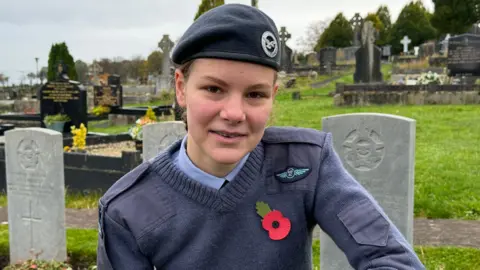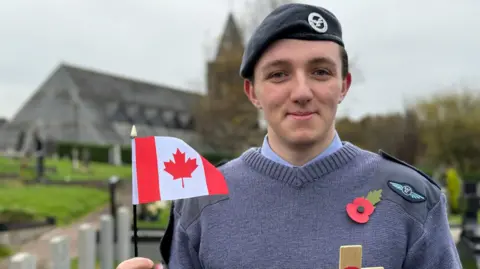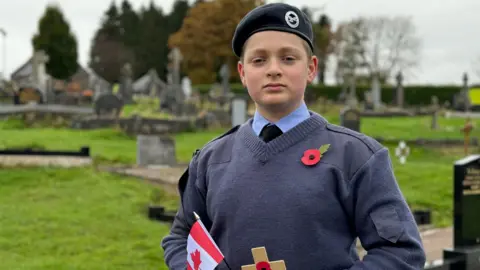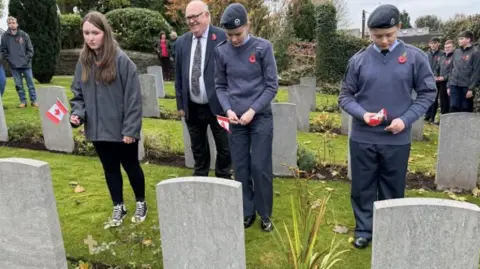Cadets remember Canadian airmen of WWII
 BBC
BBCA small town in County Fermanagh is the final resting place for 82 young airmen.
They lie in neat rows of Commonwealth war graves in both the Roman Catholic church cemetery and the Church of Ireland cemetery in Irvinestown.
It is the largest group of World War Two Air Force graves in Northern Ireland.
More than half of those who died are buried thousands of miles from their homes in Australia, Canada and New Zealand.
But how did they come to be there?
It is a reminder of the role the area played in the Battle of the Atlantic between 1941 and 1945.
Lough Erne was a base for RAF Coastal Command flying boats protecting Allied shipping convoys in the Atlantic.
Secret deal with the Republic of Ireland
A secret deal with the Republic of Ireland allowed the planes to fly through Irish airspace.
They flew along a route that became known as the Donegal corridor, a shortcut that linked Lough Erne with the Atlantic Ocean and extended the range of the aircraft.
To mark the centenary of the Royal Canadian Air Force, young army and air cadets from Enniskillen and Omagh placed a small Canadian flag and a poppy cross on each of the 38 Canadian graves.
The teenagers are just a few years younger than the pilots, navigators, air gunners, and wireless operators whose names and ages are recorded on the headstones.

Air cadet Oliver Irwin from Omagh said: “When you see a Canadian person who’s died here you think ‘what happened?’, you want to learn their story.”
Jacob Woods, an army cadet from Enniskillen, did not realise so many airmen who served in Northern Ireland came from Canada.
“As a young person I feel it’s important to remember all these young people who served their country and died, and gave the ultimate sacrifice,” he said.
Valeriya Baderdinova, an air cadet who is originally from Ukraine, was also surprised to find so many Canadian graves here.
“It’s really important to remember everyone who died for us and who served their own country,” she said.

Air cadet Torin Aleksanderek from Poland was taking part in a remembrance service for the first time.
He said: “I think it’s really important for the new generation to learn about these things, the tragedies, the brave men that were lost.”
In reality, the 82 graves represent only a fraction of the total number of men lost from the bases.
Several crews simply failed to return, while others are thought to still lie below the surface of the lough.
The wreck of one aircraft, thought to be a Catalina, was discovered in 2018 and is protected as a war grave.

The Honorary Canadian Consul in Northern Ireland Ken Brundle also laid a wreath during the ceremony in Irvinestown.
“The Canadian government is very reliant upon local people conducting acts of remembrance but also looking after the war graves,” Mr Brundle said.
One of the pilots buried in St. Tighernach’s Church of Ireland cemetery is Terence Ramsay Hailstone.
Aged just 20, he was killed when his plane crashed into a nearby bog at Knocknagore in February 1945.
Years later, Pat Keenan from Irvinestown discovered his bracelet at the crash site.
He sent photographs of his find to Canadian newspapers and a journalist at the Vancouver Sun knew the pilot’s sister.
“One morning I got a phone call from this lady and she was so excited,” Mr Keenan recalled.
“She used to send me ten Canadian dollars to come here and put flowers on the grave, and I still do it.
“They’re young men who came from a foreign country and died for our freedom.
“Irvinestown being the town that it is, it’s just part and parcel of Irvinestown.”
